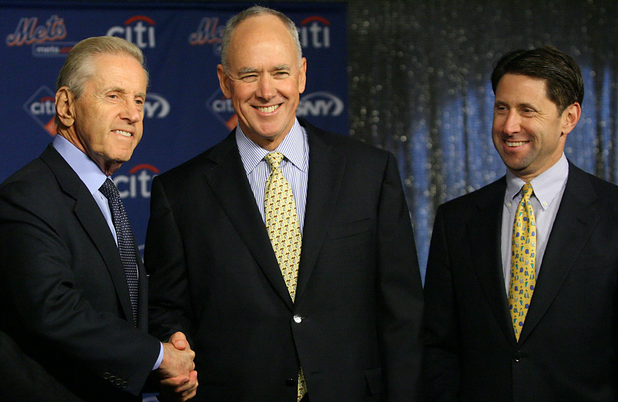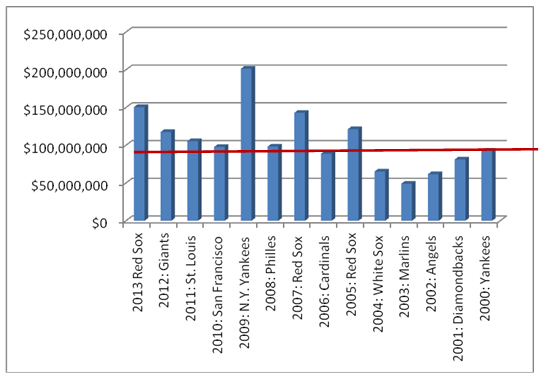
An MMO Fan Shot by Ryan Flanagan
One of the biggest, if not the biggest, points of contention between Met fans and its ownership is the current state of payroll and spending power. The Mets, in the largest market in the United States, held a payroll in the bottom 10 in baseball and in 2013 that ranked 22 out of 30 total teams. This, in a market where a borough away another MLB team held a payroll of over $238 million in 2013, roughly $161 million dollars greater than the Mets. In fact, the Yankee payroll was over three times the Mets last season. I know, it’s not fair to compare to the Yankees. That said, it’s not just the Yankees that have far surpassed the Mets spending power.
To get a sense of Met fan frustration, the Mets have not been a broke franchise. In fact, in a vacuum, the team should be set up to have a great ability to spend. Though the team’s finances are tight-lipped and generally unknown to the public, there are certain revenue streams that cannot be ignored and that fail to make their way to improving a baseball team that boasts a majority of minor league players on a major league roster.
SNY: Sportsnet New York has been a very successful venture for the Mets. The network, shared by Time Warner, Comcast and the Mets has seen tremendous revenues in recent years. Quoted by Forbes.com, the revenues for the network were $268 million in 2012. The Mets, whom own a 65% stake in the network, would have received a $174.2 million dollar profit in that year alone. (The numbers aren’t yet out for 2013) While this would seem an obvious revenue source for payroll flexibility, the Mets use leverage those funds to pay debts and litigation fees.
MLB TV Deal: The MLB struck blockbuster deals with ESPN, TBS and FOX for game airing rights, both running through 2021. The ESPN deal is worth $700 million and the TBS and FOX deal is worth $800 million. This $1.5 billion TV contract awarded each team 25 million to spend in 2013, at the team’s discretion. Again, while this would normally be seen as a no-brainer to improve payroll, it’s unknown where the funds will end up. The $25 million received from the MLB, alone, can nearly pay for all the Mets 2013 acquisitions.
Selling Shares of the Team: The Wilpons, in a desperate attempt to salvage ownership of the struggling franchise, sold off 48% of the team to investors to the tune of $248 million dollars. This, of course, was not used for the team but rather to pay for their own financial conflicts and debt accumulation.
Amway Deal: In a rather head-scratching move, the Mets brought Amway into Citi Field, after the company paid out $155 million in lawsuits due to similar illegality of financial moves. Sound familiar? While the terms of the deal between the Mets and Amway was not publicized, the Mets are surely getting revenue from the company to hold a storefront on the blighted 126th street.
Advertisements: Citi Field, as gorgeous and enjoyable as it is, houses a tremendous amount of advertising seemingly on every surface in the ballpark. Though the revenue numbers are unknown, it is surely a lucrative venture for the Mets.
MLBAM: The MLB Advanced Media deal is the general fund of online ticket sales, MLB shop sales, content subscriptions and advertising/sponsorships. In 2012, the revenue totaled $650 million dollars which each team receiving around $100 million in revenue, which is estimated to be reach $150 million a team in 2013.
Gate Sales: It’s been widely documented that the Mets have had declining attendance as a result of the recession and declining performance. That said, the Mets still grossed 84 million in sales ranking 21st in the league in attendance.
2013 Revenue: The Mets, even at one of the worst stretches in a long time, ranked 11th in total revenue in 2013 at $232 million. Even with low attendance and a struggling team, the Mets still remain among the top in revenue.
Deal with Citi: While the Mets are on the hook for roughly $600 million to build Citi Field, which would typically seen as a major hurdle, is being subsidized $400 million by Citicorp on a 20 million per-year deal. That limits the Mets stadium obligations to around just $200 million which should be manageable.
While the above remain the largest revenue streams, the Mets also gain revenue from several other sources. Below is a list of 2012 stadium-only revenue for the Mets, provided by Newsday:
REVENUE, 2012 (as of Sept. 30)
Retained seats: $44,111,395*
Advertising: $44,170,209
Concessions: $11,986,369
Luxury suite: $8,583,116
Parking: $7,167,770
Other: $2,642,348
Revenue total: $118,661,207
*Represents about 25 percent of all tickets sold; includes 10,635 premium seats. Source: New York City Industrial Development Agency
So, how much does it take to win?
The Mets payroll, in early January 2013, stands at $85.9 million dollars. That is set to be near the bottom of the MLB with the likes of Tampa Bay, Houston and Florida – a place the Mets never want to be. So much discussion centers on payroll to the literal dollar amount, so I did some research on the past 13 World Series Champion payrolls to see what winning clubs have been paying on average in an effort to bring fact to argument.
** Of course, inflation over that decade plays a major role in payroll as the early 2000s produced contracts that don’t even compare to those given out in 2013.**
|
World Series Champion |
Payroll (dollars) |
| 2013 Red Sox | $150,655,500 |
| 2012: Giants | 117,620,683 |
| 2011: St. Louis | 105,433,572 |
| 2010: San Francisco | 97,828,833 |
| 2009: Yankees | $201,449,289 |
| 2008: Philles | $98,269,881 |
| 2007: Red Sox | $143,026,214 |
| 2006: Cardinals | $88,891,371 |
| 2005: Red Sox | $121,311,945 |
| 2004: White Sox | $65,212,500 |
| 2003: Marlins | $49,050,000 |
| 2002: Angels | $61,721,667 |
| 2001: Diamondbacks | $81,206,513 |
| 2000: Yankees | $92,538,260 |
| Average Payroll | $105,301,159 |
| Mets 2013 Payroll | 85,900,000 |

Figure 1: World Series Championship Payrolls. *Red Line signifies Mets 2013 Payroll
The average payroll of World Series Champions, over the past 13 years, is $105,301,159. There are a few cases where teams that didn’t spend a lot won the championship. That list includes the Angels in ’02 with a payroll of $61,721,667, the Marlins in ’03 with a payroll under $50 million and the ’04 White Sox with a payroll of $65 million. It must be noted, however, that the payrolls of the ’02 Angels and ’03 Marlins were not that low by payroll standards at the time. The only other team that arguably didn’t spend a great deal to win could be the 2006 Cardinals who spent $88 million, but that still was a reasonable number 8 years ago.
So what does this mean?
Beyond the 3 or 4 teams out of the past 13 champions that won on limited budgets, the rest have spent considerably to win.
The notion that spending does not equate to championships is rather a poor-man’s perspective. Sure, teams have been able to win by not spending a lot, but they are anomalies and the minority of champions.
Every team, beyond the few mentioned that won with little, spent over $95 million to win the World Series. If you exclude the Cardinals, the low-budget winners account for only 23% of teams that won over the past 13 years.
That means roughly 77% of teams that have won the World Series over the past 13 years, have done so with “big” payrolls.
That is just statistical fact, no matter how you look at it.
Does this mean the Mets have to spend over $105,301,159 in order to compete? Of course not, but under-spending the way the club has does not seem like a promising recipe for success. By the data, it looks as if the Mets would want to spend at least around 100 million to contend. Who knows, maybe they are that anomaly. Maybe the Mets have enough young talent to overcome the lack of experienced, proven MLB talent that comes with spending money. I won’t hold my breath, however.
* * * * * * * *
This Fan Shot was contributed by Ryan Flanagan. Have something you want to say about the Mets? Share your opinions with over 25,000 Mets fans who read this site daily. Send your Fan Shot to [email protected]. Or ask us about becoming a regular contributor.















